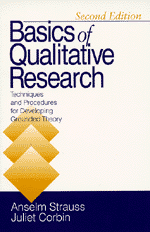

![]()
![]()

The book is in three sections. The first, 'Basic Considerations', introduces the ideas and assumptions of the grounded theory approach. In this section the key elements of the approach, such as the idea of 'grounding' theory in data and the differences between 'description', 'conceptual ordering' and 'theory' are explained. Also in this section Strauss and Corbin emphasize two key points: (a) the foundational role in any qualitative research of participants' own understandings of their social environment, and (b) the importance of flexibility, the need for researchers to be creative and tailor the approach to their own research settings and interests. The pursuit of rigour and objectivity, essential though these are, must not turn into a mechanistic adherence to pre-set methodological formulae.
The second, and major, part of the book, 'Coding Procedures', explains the different forms of conceptual ordering, or 'coding' that qualitative researchers may employ and the relationship between these. The coding techniques are presented and discussed in a 'natural' developmental order, in terms of a process of analysis from concrete to abstract. Thus the section begins by introducing the idea of 'microanalysis', focusing attention on the specific content of actual conduct, illustrated by exercises designed to attune students to the intense detail of social action and language. This is followed by chapters on, respectively, 'open coding', 'axial coding' and 'selective coding'. Essentially, open coding refers to the process of generating initial concepts from data, axial coding to the development and linking of concepts into conceptual families, and selective coding to the formalising of these relationships into theoretical frameworks. All through the explication of these ideas, the emphasis is firmly upon practicalities. To this end, a significant difference between this edition and the first is the extensive use of 'real materials' - extracts from field notes and transcripts - to illustrate the abstraction process. Reference is continually made to actual research projects, to problems researchers encountered in interacting with their data and the means by which these problems were handled. All of this gives the book a very strong 'hands on' feel, much more so than some other qualitative methods texts.
The final section, 'Gaining Closure', focuses on the presentation of findings in written and oral form, and upon the criteria for evaluating qualitative studies. The remarks on the former are rather bland and trite; far more useful is the list of criteria the authors suggest for judging the adequacy of studies. These provide students with a clear guide to what to look for methodologically when reading qualitative accounts.
Grounded theory has been a success story. As the authors note, it has been taken up and used by social researchers across a wide range of disciplines, from 'pure' ones like sociology and social psychology to 'applied' ones such as education, health studies and management studies. Where once qualitative inquiry was regarded as little more than a preliminary to 'real', i.e. quantitative, scientific analysis, researchers have come to see that only through ethnographic methods can the in situ reality of actual social settings be accessed and analysed. A lion's share of the responsibility for this change lies with Anselm Strauss. Over the past twenty or so years grounded theory has become by far the most popular ethnographic strategy, and Strauss's writings have been massively influential in changing prevailing attitudes towards qualitative research in the social sciences. If this book is his epitaph, it is fitting that it should be one which encourages others to go out and investigate the social world at first hand and in its naturally occurring detail.
Dave Francis
Manchester Metropolitan University